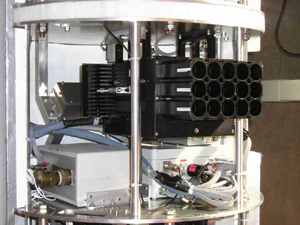Purpose of the flight and payload description
It is an uprgraded version of the RADIBAL (RADIometre BALlon) infrared polarimeter developed by LOA during 1998/1999 and used to observe aerosols ant other particles in the atmosphere.
The instrument has been miniaturized, to allow an easier launch without an auxiliary balloon. The measurements are performed in 5 channels (instead of 2 in RADIBAL) centered in the near infrared at 730 nm, 865 nm, 1000 nm, 1270 nm and 1620 nm. The three first channels are equipped with silicium detectors while the two others are InGaAs detectors cooled by a one stage Peltier module.
The instrument is composed of 15 separate optics whose axes are parallel, with narrow fields of view. They are arranged in groups of 3 for each wavelength, the 3 optics being equipped with analyzers positioned 60º one from each other in order to derive the polarized light. The radiometers detect the sunlight scattered by the atmosphere (gas and particles) enabling radiance and degree of polarization of the scattered sunlight to be inferred. Owing to the rotation of the gondola around its vertical axis, the observations are performed under various directions in a horizontal plane. Scans are thus obtained with an angular sampling of about 2-6º depending on the rotation rate.
A magnetometer helps to determine the azimuth direction of the line of sight and to deduce the corresponding scattering angle with respect to the solar incident light.
Details of the balloon flight
Balloon launched on: 1/25/2000 at 9.03
Launch site: European Space Range, Kiruna, Sweden
Balloon launched by: Centre National d'Etudes Spatiales (CNES)
Balloon manufacturer/size/composition: Zero Pressure Balloon model 10zl 10.000 m3
Balloon serial number: 10ZL Nº 83
End of flight (L for landing time, W for last contact, otherwise termination time): 1/25/2000 at ~ 10.15
Balloon flight duration (F: time at float only, otherwise total flight time in d:days / h:hours or m:minutes - ): 1 h 8 m
Campaign: THESEO 2000
Payload weight: 71 kgs
Gondola weight: 27 kgs
The microRADIBAL instrument was launched from Esrange at 09:00 UT on 25 January 2000 since a PSC was clearly observed from the ground. The measurements are usually performed during the ascent or the descent of the balloon, and the aerosol are studied at several altitudes. During this flight, due to trajectory constraints, measurements were made during the ascent of the balloon. Due to some problems in the flight train (twisting) the gondola sometimes rotated very fast and thus only sequences in the 17-21 km range could be used.
The 17-21 km altitude level was reached at about 10:00UT, the balloon position being about 66.7ºN/22ºE.
External references
- microRADIBAL website Laboratoire d'Optique Atmosphérique, Université Lille
- An overview of the SOLVE/THESEO 2000 campaign Journal of Geophysical Research (Atmospheres), Volume 107, Issue D20, pp. SOL 1-1
- List of balloons launched from ESRANGE SSC Space website (via Archive.Org)
- PSC microphysical properties measured by microRADIBAL instrument on January 25, 2000 above Esrange and modeling interpretation Journal of Geophysical Research, Vol. 108, No. D6, 8332
1325If you consider this website interesting or useful, you can help me to keep it up and running with a small donation to cover the operational costs. Just the equivalent of the price of a cup of coffee helps a lot.


